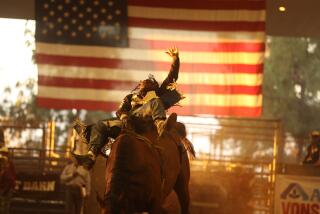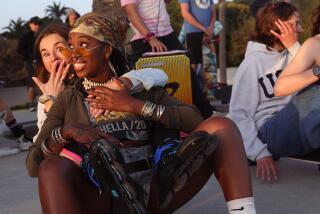Sentimental Journey
- Share via
VENTURA — Bandaged but optimistic, bruised but energetic, about 2,600 participants of the fifth annual California AIDS Ride peddled into San Buenaventura State Beach on Friday afternoon for the last overnight stop in a journey from San Francisco to Los Angeles.
Each had a story to tell about what has allowed them to make the 560-mile journey, which will raise $9.5 million this year. Some have AIDS. Some have lost friends or family members to the disease. And some just think it is a worthwhile cause.
“I’m healthy and a lot of my friends weren’t,” said Joel Thurm of Los Angeles, one of only 14 riders to participate in all five of the fund-raisers.
Thurm said he can’t explain what keeps him riding each year but that he will continue to participate.
“It doesn’t make any sense logically, but it makes a lot of sense internally,” said the 46-year-old.
After six days of riding, Arthur Levine of Irvine has both knees bandaged and said it has been a struggle to keep going. But he has realized how much self-discipline he has.
“It’s a time for an ordinary person to do an extraordinary thing,” said Levine, who is on his first AIDS Ride but plans to participate again next year.
Ordinary people making a remarkable journey is why the Ventura County Chapter of Parents, Friends and Families of Lesbians and Gays cheered riders along Pacific Coast Highway at Faria Beach.
Jean Culver of Camarillo lost her son, John, five years ago to complications related to acquired immune deficiency syndrome. She honors his memory by cheering on the riders and holding a sign that reads, “Blessings and Huge Thanks.”
“You know, it doesn’t matter what they die from . . . the loss is the same,” Culver said. “You just can’t sit in the house. You have to do something.”
A few miles south of Faria Beach, three Bay Area residents wearing tutus and leather stood along the bike route cheering riders.
“We’re so thankful to the riders so we want to give them support. Every little bit helps,” said Paul Sullivan of San Francisco.
Riders must raise $2,500 from sponsors to participate in the event, which has raised about $24 million since it began in 1994. This year, 38% will go to overhead costs.
Others calculate that percentage as high as 50%. Critics contend not enough of the millions raised goes to the organizations that benefit from the ride--the L.A. Gay and Lesbian Center and the San Francisco AIDS Foundation.
But Lorri L. Jean, executive director of the L.A. Gay and Lesbian Center, doesn’t agree. She said the ride’s administrative costs aren’t that much more than other fund-raisers.
“We wouldn’t be able to raise this money without it being a pledge event,” Jean said.
Recently, critics within the AIDS activist community have spoken out against the ride, contending the event is too scripted, with staff members trained to cry while enrolling potential participants and some riders designated as spokespeople.
“What we do is we train a number of people from each locality how to be on camera so they aren’t nervous, because sometimes we have people totally freeze up,” Jean said. “Pretty much from there, we leave them on their own.”
But organizers require that visitors to AIDS Ride camps--even at public facilities, such as state parks--be escorted by a staff member.
Jean said it is important for ride participants to be able to maintain their privacy, and the staff works to protect it.
Despite criticism, the event continues to grow each year, with more participants and money being raised.
In her first year on the ride, Luella Hill of Los Angeles said the pain she feels after falling off her bike Friday and riding as much as 90 miles a day for the past week pales in comparison to the daily suffering of those who live with AIDS.
“For these seven days, we forget everything else,” the 29-year-old Marina del Rey resident said. “It’s about getting through the ride.”
More to Read
Sign up for Essential California
The most important California stories and recommendations in your inbox every morning.
You may occasionally receive promotional content from the Los Angeles Times.













